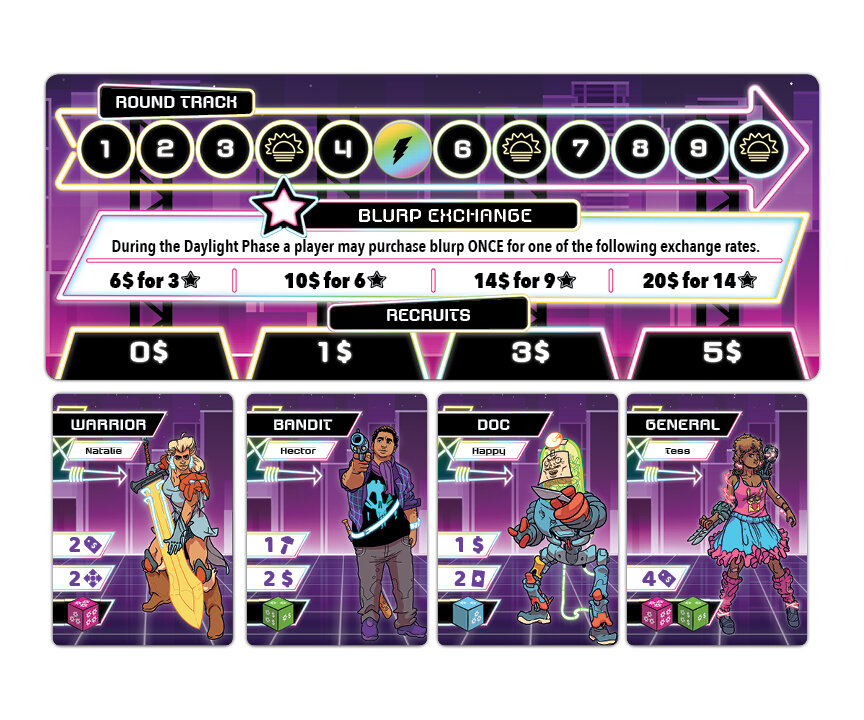Neon Gods – First Impressions
It’s the future year of 2009, and blurpin’ ain’t how it used to blurp…
Get a bunch of drooling joovs you love tripping the neon with, snag a place to call your own, then get your racket cranking. The corpies in their suits and day jobs all wanna break bad when the sun powers down, and that’s when you snag their rolls…
But you won’t be alone out there. There is a lot of fish swimming in the ultraviolet ocean, and they got teeth like you. You’ll need to delete fool yoots who come sniffing your streets, and when they bring biz to your blocks, you’d better take it for yourself…
You’ve gotta love a game where lame old victory points are called “blurp” and everything is drenched in deep neon colors. If The Wire was set in Las Vegas and visualized by Jackson Pollock, it might look like Neon Gods. Or if BladeRunner had the manic energy of Mad Max, then it might feel like Neon Gods.
This is a 2018 release from designer Isaac Vega and publisher Plaid Hat Games. It’s a tale of street gangs, goods to be sold, and android cops to avoid. The area control game bursts with a kaleidoscope of vibrant colors and it shows off some design choices that I haven’t seen in many other games in the genre. Granted, I haven’t played a ton of area control games, but those elements strike me as something worth paying attention to.
If you’re a fan of the ‘80s cyberpunk nostalgia and that visual sprawl, then the eyecatching look of Neon Gods will definitely be a positive. But gameplay above all so let’s head over to the blocks and see what all the blurp is about.
What It Does
As gang leaders of The Mums, Disco Tykes, Brute Yoots, and Huffmonkeys, players will need to build up the gang by getting new recruits, push forward and claim new territory, build up structures to support your gang’s network in the city, and then defend against any advances from other gangs.
There are three phases throughout the game where gangs will score for what they’ve conquered and kept at that point, so it’s important for players to keep their gangs fortified and ready for the next territorial encroachment, whether their own or someone else’s. After nine rounds, the gang with the most blurp wins.
Gaining new recruits bolsters a gang’s ranks while giving them more card abilities to use.
Activating events is a way to interrupt the regular flow of play to a special effect.
Card abilities are the bread and butter of the Neon Gods’s toast. These will help players get money, move around on the map, retrieve discarded cards, build structures, sell products, and do just about everything they need in the city.
And then battles conclude every player turn where contested territory becomes uncontested territory… as soon as the loser is kicked out!
Moving through these steps every player's turn will smoothly guide the game through the nine rounds and end with the blurping best blurper in this whole blurping city.
How It Does It
It’s mainly area control. But there’s some coin economy too, with gang members who can provide money and buildings that can create products to see. Money is valuable because it allows players to recruit gang members or events that are further in the market queue. It also is the only way to build structures, so that’s essential if you’re planning on creating a network of support beyond the gang members moving about on the board.
Where players will spend most of their time is in the chain of card abilities they can activate on their turn. Neon Gods is pretty free with how much players can combine the abilities of those cards to create the best turn for them. Drawing new cards, bringing old ones back from the discard, and using them to build, sell, move, and fight. It’s all possible depending on the recruits in your hand.
The most effective strategy comes in setting up a full three rounds of play to prepare for the daylight phase. That will happen three times across the nine rounds and it’s where you’ll maximize your points. So it’s area control with intermittent scoring phases. One bad round won’t kill the game for you, but it could be very detrimental in setting up for the next daylight phase.
And the different scenarios that players will use to set up the game make for a completely different spatial puzzle each time. That’s where the variability will come into play because the player count should really stay at three or four. So the combination of different tokens in the scenarios and fluid player choices in each game will create the unique experience you’re looking for.
Why You Might Like It
There are some compelling mechanics interwoven into the Neon Gods gameplay experience. While there are traditional structures like Watchtowers that can increase the security of a location, there are also money-focused and Blurp-focused buildings available for players who want to experiment with the economics and victory-point chasing parts of the game.
The combination of new gang recruits, event cards, and action selection gives each player a palette of neon-infused and colorful choices for every turn. Build a Factory and sell some Products. Or maybe Recruit a General, use a Doc to revive some gang members, and push forward to take over a key location. It’s all possible depending on how you use the actions on your turn.
Why You Might Not
I’m not entirely convinced that there is enough time to fully explore some of the potential design elements in Neon Gods. Nine rounds sound like a lot initially, but it doesn’t let you explore the economic portion of the game as much as it could, especially when players can likely interfere or even fully capture the infrastructure that you’ve planned.
As a possible critique of bullish corporations, cutthroat industry, and societal conflict, Neon Gods definitely works, but I’m not sure as an area control game if all of the individual pieces feel as rewarding as they could be for players. It doesn’t feel strong at two players. It’s too swingy. But it would likely open up and become a more engaging experience with three or four players who are exploring the different scenarios.
Final Thoughts
I haven’t played a ton of area control games. They’re not my go-to genre.
And I instinctively like what Neon Gods has to offer. The combination of Factories and Products, Monuments and Watchtowers, as well as Andies and Owls, creates a landscape for players to manipulate. Seize control and try to maintain a hold on the infrastructure of the city. And combat will allow players to push back at their opponents without ever truly wiping anyone out. They may create an uneven strength dynamic between players, but it doesn’t involve player elimination or other mechanisms that fully take someone out of the running. The Tunnels and other components in the games also lend an air of danger and opportunity given the need of a player at any given moment.
But, I’m not sure everything fully gels together. After I learned how to play, the two-player game went smoothly, but it was a lopsided affair. In terms of capitalizing on the economic system and the construction opportunities in the game, I didn’t think nine rounds was enough time. I thought 12 would be better suited toward what players could achieve when pursuing those interesting choices. With two players, however, nine rounds were definitely the right amount of time because of how unevenly the game was progressing. One player had established a central hold on locations with a sizeable amount of gang members spread across those squares. Since adjacency is important when tabulating battle strengths, that player was continuously able to keep a lock on those positions while forcing the other player back to their base.
So unless two players are able to maintain a remarkably balanced fight, one player will start to pull away. There was a Blurp chasm between them by the end of the game.
With 3 or 4 players, this could definitely be rectified by a standout leader being targeted by more than one opponent, so the balancing there is easier. I’m just not sure I’d recommend it for two players.
If player balancing wasn’t an issue, though, I do go back to the critique that the most engaging part of the game to me isn’t fully realized or given the room to breathe (i.e., the gradual build-up of economic opportunities within the controlled space that gangs are fighting over). For fans of the area-control genre, the small permutations in this game that make it differ from other entries with similar mechanisms might be enough to entice you to the table again and again.
For now, it’s a game that I’ll pass on, but I’d love to be wrong and get a chance to play it again in the future.
If you want to check out Neon Gods, you can learn more about Plaid Hat Games or read what the community thinks on BoardGameGeek.
This is a really interesting area-control game that involves spatial economics and the potential for a lot of flux between competing players.
Let us know in the comments and give a recommendation for other games of which to share our first impressions.





